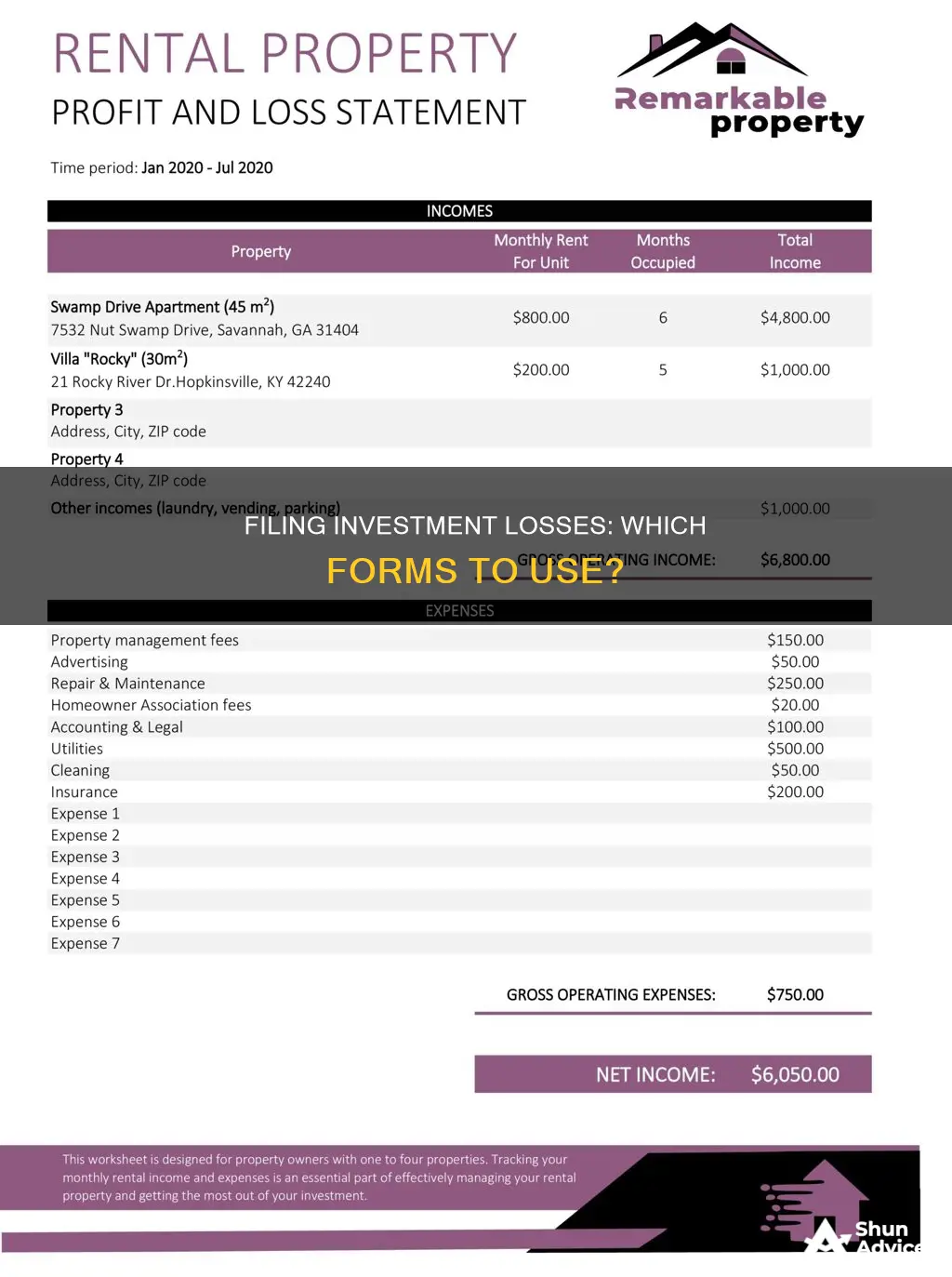
To file an investment loss, you will need to fill out IRS Form 8949 and Schedule D.
| Characteristics | Values |
|---|---|
| Form Number | 8949 and Schedule D |
| Form Name | Sales and Other Dispositions of Capital Assets |
| Use | To deduct stock losses on your taxes |
What You'll Learn

Capital gains and losses
Net capital gains are taxed at different rates depending on overall taxable income. For example, for taxable years beginning in 2023, the tax rate on most net capital gains is no higher than 15% for most individuals. A capital gains tax rate of 0% applies if your taxable income is less than or equal to $44,625 for single and married filing separately; $89,250 for married filing jointly and qualifying surviving spouse; and $59,750 for the head of household.
If your capital losses exceed your capital gains, you can claim the lesser of $3,000 ($1,500 if married and filing separately) or your total net loss shown on Schedule D (Form 1040), Capital Gains and Losses. If your net capital loss is more than this limit, you can carry the loss forward to later years. You can use the Capital Loss Carryover Worksheet in Publication 550 or the Instructions for Schedule D (Form 1040) to figure out the amount you can carry forward.
To report capital gains and losses, you must first record detailed information about them on Form 8949, Sales and Other Dispositions of Capital Assets. You then provide this form to the Internal Revenue Service (IRS) with your tax return so that they can compare the information with that reported by brokerage firms and investment companies. Finally, you transpose the final net number from Form 8949 to Schedule D and then to Form 1040.
Recording Cash Investments: A Step-by-Step Guide for Beginners
You may want to see also

Short-term vs long-term capital gains and losses
When you sell a capital asset, the difference between the adjusted basis in the asset and the amount you realised from the sale is a capital gain or a capital loss. Capital gains and losses are classified as long-term or short-term.
Short-term capital gains and losses
Short-term capital gains and losses refer to profits or losses made from selling assets you've held for a year or less. Short-term capital gains are taxed at the same rate as your ordinary income, which can be anywhere from 10% to 37%, depending on your income and filing status.
Long-term capital gains and losses
Long-term capital gains and losses refer to profits or losses made from selling assets you've held for more than a year. Long-term capital gains are taxed at a lower rate than short-term gains and income taxes, ranging from 0% to 20%, depending on your taxable income.
Net capital gains and losses
Net capital gains or losses are calculated by combining short-term and long-term capital gains or losses. If you have a net capital gain, a lower tax rate may apply to the gain than the tax rate that applies to your ordinary income. The term "net capital gain" means the amount by which your net long-term capital gain for the year is more than your net short-term capital loss for the year. The term "net long-term capital gain" means long-term capital gains reduced by long-term capital losses, including any unused long-term capital loss carried over from previous years. The term "net short-term capital loss" means the excess of short-term capital losses (including any unused short-term capital losses carried over from previous years) over short-term capital gains for the year.
Reporting capital gains and losses
You must report most sales and other capital transactions and calculate capital gains or losses on Form 8949, Sales and Other Dispositions of Capital Assets, then summarise capital gains and deductible capital losses on Schedule D (Form 1040).
Warren Buffet's Strategy for Investing Berkshire's Cash Reserves
You may want to see also

Tax rules for capital losses
When it comes to filing an investment loss, there are a few key tax rules for capital losses that you should be aware of.
Firstly, it's important to understand what constitutes a capital loss. A capital loss occurs when you sell a capital asset, such as stocks, bonds, real estate, or personal property, for less than its adjusted cost base, which includes any expenses involved in selling the property. This loss can then be used to offset your capital gains, reducing your taxable income.
In terms of tax rules, capital losses can be classified as either short-term or long-term. Short-term losses occur when you sell an asset that you've held for less than a year, while long-term losses are for assets held for a year or more. This distinction is important because losses (and gains) are treated differently depending on their classification. Generally, short-term capital losses are used to offset short-term gains, and long-term losses are used to offset long-term gains.
If your capital losses exceed your capital gains, you may have a net capital loss for the year. This net loss can be carried forward to subsequent years and used to offset future capital gains or other types of income. There may be limits to how much of the net loss you can claim each year, depending on your tax jurisdiction.
Additionally, it's worth noting that losses from the sale of personal-use property, such as your primary residence, car, or furniture, may not be tax-deductible.
To claim capital losses, you will need to fill out specific tax forms, such as Form 8949 and Schedule D in the U.S., or Schedule 3 in Canada. These forms will help you calculate your total net capital gain or loss and determine how much you can deduct from your taxable income.
It's always a good idea to consult with a tax professional or financial advisor to ensure you're complying with the relevant tax laws and maximizing your tax benefits.
A Comprehensive Guide to Using Quicken for Investments
You may want to see also

How to calculate a capital loss
To calculate a capital loss, you must first understand what a capital loss is. A capital loss is a reduction in the value of a company's capital, i.e. investments, capital assets, etc. It is realised when capital assets are sold for a price lower than the original price.
The formula for calculating a capital loss is:
> Capital Loss = Purchase Price – Sale Price
For example, if you bought a stock for $100 and sold it for $80, your capital loss would be $20.
It is important to note that capital losses are divided into two categories: short-term capital losses (held for less than a year) and long-term capital losses (held for one year or longer). These categories are crucial for taxation purposes, as they are treated differently when offsetting capital gains.
To calculate your total net capital gain or loss, you must first calculate your short-term and long-term capital gains and losses separately. This is done by filling out Form 8949 and Schedule D with your tax return.
Once you have calculated your short-term and long-term capital gains and losses, you can then calculate the total net capital gain or loss by combining the two.
If you have a net capital loss, you may be able to deduct this from your taxable income, up to a certain amount, depending on your filing status. For example, for the 2023 tax year, single filers or those married and filing jointly can deduct capital losses up to the amount of their capital gains plus $3,000. Any excess net capital loss can be carried over to subsequent years.
Cash Reserve: A Smart Investor's Safety Net
You may want to see also

Capital loss strategies
When it comes to filing an investment loss, there are a few key capital loss strategies to keep in mind. Here are some detailed instructions on how to approach them:
Calculate Your Capital Gains and Losses
Firstly, it's important to calculate both your short-term and long-term capital gains and losses. Short-term losses occur with assets held for less than a year, while long-term losses occur when assets are held for a year or more. This distinction is crucial as short-term and long-term gains and losses are treated differently for tax purposes.
Determine Your Total Net Capital Gain or Loss
The next step is to calculate your total net capital gain or loss by combining your short-term and long-term gains and losses. This will give you a clear picture of your overall capital position.
Use an Overall Loss to Offset Taxable Income
If you have a net capital loss, you can use it to offset taxable income. In the United States, you can deduct up to $3,000 of capital losses against ordinary income if you don't have capital gains to offset. If you're married and filing separately, this deduction is limited to $1,500.
Carry Forward a Loss
If your net capital loss exceeds the deductible amount, you can carry the remaining loss forward to future tax years. This strategy allows you to continue reducing your taxable income or offsetting future capital gains until the total loss is applied.
Understand Wash-Sale Rules
It's important to be aware of wash-sale rules. The IRS does not allow you to claim a loss on the sale of a security if you repurchase the same or a substantially identical security within 30 days. This rule aims to prevent taxpayers from taking advantage of the capital loss deduction.
Choose the Right Stop-Loss Strategy
When deciding to sell an investment at a loss, consider using a stop-loss strategy. This involves placing a stop-loss order with a broker to buy or sell a security when it reaches a certain price to limit potential losses. There are several types of stop-loss strategies, including risk-per-trade, risk-reward, volatility, support and resistance, and trailing stop-loss approaches. Choose the one that aligns with your risk tolerance and trading strategy.
Consult a Financial Advisor
If you need help navigating capital loss strategies and tax implications, consider consulting a financial advisor or tax professional. They can provide personalized advice and ensure you're making informed financial decisions.
Cashing Out Your GCash Investments: A Step-by-Step Guide
You may want to see also
Frequently asked questions
To file an investment loss, you will need to fill out IRS Form 8949 and Schedule D.
A capital loss occurs when you sell a capital asset for less than you bought it.
First, calculate your net short-term capital gain or loss by subtracting short-term losses from short-term gains. Then, calculate your net long-term capital gain or loss by subtracting long-term losses from long-term gains. Finally, combine these two to determine your total net capital gain or loss.
An asset or investment that is held for a year or less and sold at a loss will generate a short-term capital loss. An asset or investment held for more than a year and sold at a loss will generate a long-term loss.
The IRS limits your net loss to $3,000 (for individuals and married filing jointly) or $1,500 (for married filing separately).







